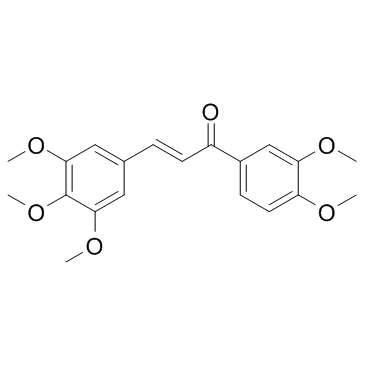| Description |
MD2-IN-1 is an inhibitor of Myeloid differentiation protein 2 (MD2) with a KD of 189 μM for the recombinant human MD2 (rhMD2).
|
| Related Catalog |
|
| Target |
KD: 189 μM (rhMD2)[1]
|
| In Vitro |
Myeloid differentiation protein 2 (MD2) is a co-receptor of TLR4. Among those derivatives, MD2-IN-1 (compound 20) shows the strongest inhibitory effect on LPS-induced expression of both TNF-α and IL-6. Compare to the vehicle, LPS alone largely increases the amount of TLR4/MD2 complex, while pretreatment with MD2-IN-1 inhibits the increase of TLR4/MD2 complex to the vehicle level. SPR analysis shows that MD2-IN-1 exhibits recognizable binding to rhMD2 protein in a dose-dependent manner, with a KD value of 189 μM, while the KD value of xanthohumol binding to MD2 is 460 μM. Pre-treatment with different doses of MD2-IN-1 dose-dependently reduces FITC-LPS binding to MD2 in cell surface membranes, with a 65% inhibition at 10 μM in terms of mean fluorescence intensity. Pretreatment with MD2-IN-1 also dose-dependently blocks LPS-induced MAPK phosphorylation in the MPMs[1].
|
| In Vivo |
Administration of MD2-IN-1 evidently reduces the LPS-induced increase in protein concentrations in BALF. The lung wet/dry weight ratio is markedly higher in the LPS-treated group than the control group, and MD2-IN-1 treatment reduces LPS-induced pulmonary edema. LPS also causes observable lung histopathologic changes, including areas of inflammatory infiltration, hemorrhage, interstitial edema, thickening of the alveolar wall, and lung tissue destruction. These histopathological changes are ameliorated in the MD2-IN-1 treatment group[1].
|
| Cell Assay |
Mouse RAW264.7 macrophages are starved for 3 h before experimentation. Cells are incubated with or without FITC-LPS (50 μg/mL) in the presence or absence of MD2-IN-1 (0.1, 1 and 10 μM) for 30 min. After incubation, macrophages are fixed with paraformaldehyde for 10 min at 4°C and washed with PBS before being analyzed by flow cytometry[1].
|
| Animal Admin |
Male Sprague Dawley (SD) rats are randomly divided into three groups, designated “control” (5 rats, only receive the vehicle of 0.9% saline), “LPS” (7 rats, receive 5 mg/kg LPS alone) and “MD2-IN-1 (20) + LPS” (6 rats, receive both MD2-IN-1 and 5 mg/kg LPS). Prior to LPS-induced Acute lung injury (ALI), the MD2-IN-1+LPS group rats are treated intragastrically with MD2-IN-1 at a dosage of 20 mg/kg/day continuously for one week. Under ether anesthesia, all the rats are exposed their trachea and challenged with intratracheal instillation of 50 μL of LPS, while the control group challenged with intratracheal instillation of 50 μL of 0.9% saline. Rats are then euthanized with ketamine after 6 h of LPS induction[1].
|
| References |
[1]. Zhang Y, et al. Discovery of new MD2 inhibitor from chalcone derivatives with anti-inflammatory effects in LPS-induced acute lung injury. Sci Rep. 2016 Apr 27;6:25130.
|
